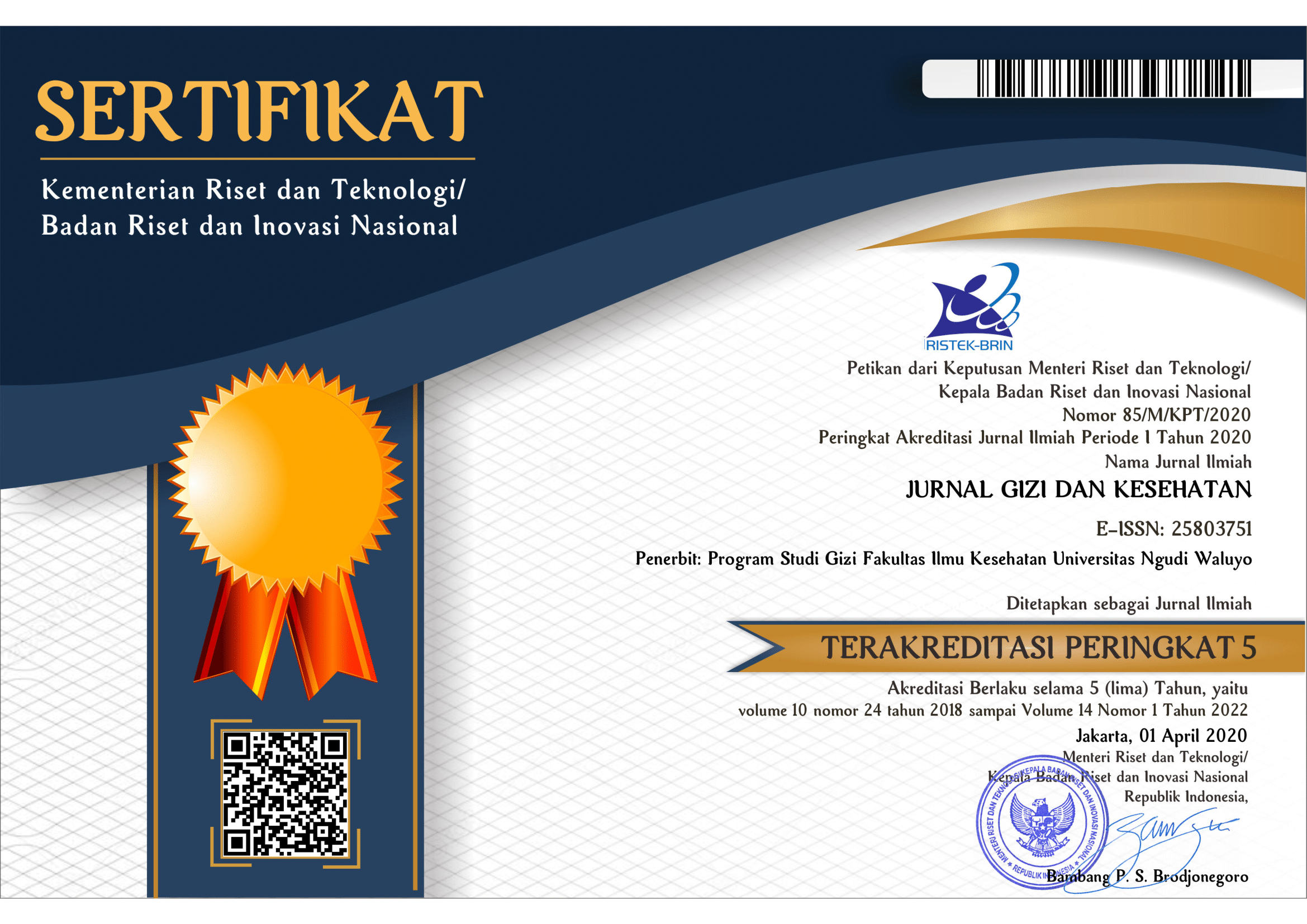Evaluasi Nilai Protein Total, Albumin, Kreatinin, dan Bilirubin pada Tikus dengan Diet Rendah Protein
Evaluation of Total Protein, Albumin, Creatinine and Bilirubin Values in Rats on a Low Protein Diet
DOI:
https://doi.org/10.35473/jgk.v16i2.582Abstract
Indonesia has a target of eliminating all forms of nutritional problems by 2030. However, cases of malnutrition in Indonesia are still relatively high, namely 21.7% stunting, 17.7% underweight, and this figure has decreased over a relatively long period of 20 years, while children's growth and development continues to run. One of the main problems is inadequate protein intake which has an impact on biological systems in the body. To solve this problem, it is necessary to understand the underlying mechanisms related to biological problems arising from malnutrition. Sampling of the human body in children is very limited, so creating experimental animal models is key to help explain biological events like the subjects observed. This study aimed to evaluate several blood biomarkers in mice given a low-protein diet. This research method was carried out experimentally by giving an LPD (Low Protein Diet) diet for 3 weeks; then blood analysis was carried out. In general, the group of experimental animals given a low-protein diet had lower values of total protein, albumin, creatinine, and bilirubin than the normal diet group. In addition, the average results of the blood analysis also have lower values than normal referent values.
ABSTRAK
Indonesia memiliki target dalam menghilangkan segala bentuk masalah gizi pada tahun 2030. Namun, kasus malnutrisi di Indonesia masih relatif tinggi yaitu 21,7% stunting, 17,7% underweight, dan angka ini menurun relatif lama dalam waktu 20 tahun, sementara tumbuh kembang anak terus berjalan. Salah satu masalah utama adalah asupan protein yang tidak akuat sehingga berdampak pada masalah biologis di dalam tubuh. Untuk mencari solusi masalah ini, memahami mekanisme mendasar yang menyeluruh terkait masalah biologis yang timbul akibat malnutrisi perlu dilakukan. Pengambilan sampel pada tubuh manusia untuk apalagi pada anak-anak sangat terbatas, sehingga pembuatan model hewan coba adalah kunci untuk membantu menjelaskan kejadian biologis yang mirip dengan subjek yang diamati. Tujuan penelitian ini melakukan evaluasi terhadap beberapa biomarker darah pada tikus yang diberikan diet rendah protein. Metode penelitian ini dilakukan secara eksperimental dengan pemberian diet LPD (Low Protein Diet) selama 3 minggu, selanjutnya dilakukan analisis darah. Hasil analisis secara umum, kelompok hewan coba yang diberikan diet rendah protein memiliki nilai protein total, albumin, kreatinin, dan bilirubin yang lebih rendah daripada kelompok diet normal, dan rata-rata hasil analisis darah tersebut juga memiliki nilai yang lebih rendah daripada nilai rujukan normal.
Downloads
References
Astuti, D.A. (2015) ‘Diet untuk hewan model’, Bogor. IPB Press., Edisi 1. J(3), pp. 1–37.
Badan Kebijakan Pembangunan Kesehatan. Kementerian Kesehatan (2022) ‘Status Gizi SSGI 2022’, pp. 1–156.
Barré-Sinoussi, F. and Montagutelli, X. (2015) ‘Animal models are essential to biological research: Issues and perspectives’, Future Science OA, 1(4), pp. 4–6. Available at: https://doi.org/10.4155/fso.15.63.
Budge, S. et al. (2019) ‘Environmental enteric dysfunction and child stunting’, Nutrition Reviews, 77(4), pp. 240–253. Available at: https://doi.org/10.1093/nutrit/nuy068.
Bünger, M. (no date) Probing the role of PPARα in the small intestine A functional nutrigenomics approach.
D’Souza, V. et al. (2022) ‘Protein Malnutrition in BALB/c Mice: An Experimental Model Resembling Clinical Scenario’, Journal of Health and Allied Sciences NU, pp. 0–6. Available at: https://doi.org/10.1055/s-0042-1758526.
Farràs, M. et al. (2018) ‘Characterizing the metabolic phenotype of intestinal villus blunting in Zambian children with severe acute malnutrition and persistent diarrhea’, PLoS ONE, 13(3), pp. 1–13. Available at: https://doi.org/10.1371/journal.pone.0192092.
Ferreira-Paes, T., Seixas-Costa, P. and Almeida-Amaral, E.E. (2021) ‘Validation of a Feed Protocol in a Mouse Model That Mimics Marasmic Malnutrition’, Frontiers in Veterinary Science, 8(November), pp. 1–10. Available at: https://doi.org/10.3389/fvets.2021.757136.
Gibson, R.S. et al. (2007) ‘Does zinc deficiency play a role in stunting among primary school children in NE Thailand?’, British Journal of Nutrition, 97(1), pp. 167–175. Available at: https://doi.org/10.1017/S0007114507250445.
Handajani, F. (2021) Metode Pemilihan dan pemnbuatan hewan model beberapa penyakit pada penelitian eksperimental.
Harper, K.M. et al. (2018) ‘Environmental enteric dysfunction pathways and child stunting: A systematic review’, PLoS Neglected Tropical Diseases, 12(1), pp. 1–23. Available at: https://doi.org/10.1371/journal.pntd.0006205.
Keller, U. (2019) ‘Nutritional laboratory markers in malnutrition’, Journal of Clinical Medicine, 8(6). Available at: https://doi.org/10.3390/jcm8060775.
Merino-Sanjuán, M. et al. (2011) ‘Modelo de desnutrición animal para la evaluación de estudios de farmacocinetica’, Nutricion Hospitalaria, 26(6), pp. 1296–1304. Available at: https://doi.org/10.3305/nh.2011.26.6.5403.
Michael, H. et al. (2022) ‘Mechanisms of Kwashiorkor-Associated Immune Suppression: Insights From Human, Mouse, and Pig Studies’, Frontiers in Immunology, 13(May), pp. 1–19. Available at: https://doi.org/10.3389/fimmu.2022.826268.
Morita, C. et al. (2015) ‘Gut Dysbiosis in Patients with Anorexia Nervosa’, PLoS ONE, 10(12), pp. 1–13. Available at: https://doi.org/10.1371/journal.pone.0145274.
De Onis, M. et al. (2019) ‘Prevalence thresholds for wasting, overweight and stunting in children under 5 years’, Public Health Nutrition, 22(1), pp. 175–179. Available at: https://doi.org/10.1017/S1368980018002434.
Pinho, R.M. et al. (2022) ‘Malnourishment affects gene expression along the length of the small intestine’, Frontiers in Gastroenterology, 2017(1), p. (in press).
Rakhmawati, Y. and Fatimah, S.N. (2022) ‘The Role of Nutrients and MCV on Stunting: A Case Study on Indonesian Early Teenagers’, Open Access Macedonian Journal of Medical Sciences, 10(E), pp. 1094–1099. Available at: https://doi.org/10.3889/oamjms.2022.9290.
Saka AO, Saka MJ, Ojuawo A, Abdulkarim AA, Bilamin SA, Latubosun L, A.MAN. (2012) ‘Haematological Profile in Children with Protein Energy Malnutrition in North Central Nigeria’, Global Journal of Medical research, 12(4), pp. 9–13. Available at: https://globaljournals.org/GJMR_Volume12/2-Haematological-Profile-in-Children-with-Protein.pdf.
Salameh, E. et al. (2019) ‘Animal models of undernutrition and enteropathy as tools for assessment of nutritional intervention’, Nutrients, 11(9), pp. 1–19. Available at: https://doi.org/10.3390/nu11092233.
Salameh, E. et al. (2020) ‘Modeling undernutrition with enteropathy in mice’, Scientific Reports, 10(1), pp. 1–15. Available at: https://doi.org/10.1038/s41598-020-72705-0.
Sari, E.M. et al. (2016) ‘Asupan protein, kalsium dan fosfor pada anak stunting dan tidak stunting usia 24-59 bulan’, Jurnal Gizi Klinik Indonesia, 12(4), p. 152. Available at: https://doi.org/10.22146/ijcn.23111.
UNICEF, WHO, W.B.G. (2021) ‘Joint Child Malnutrition Estimates’, Who, 24(2), pp. 51–78. Available at: https://www.who.int/publications/i/item/9789240025257.
World Bank Group (2018) Indonesia Accelerates Fight Against Childhood Stunting, The World Bank Group. Available at: https://www.worldbank.org/en/news/feature/2018/06/26/indonesia-fights-stunting-commitment-convergence-and-communities (Accessed: 13 December 2019).
van Zutphen, T. et al. (2016) ‘Malnutrition-associated liver steatosis and ATP depletion is caused by peroxisomal and mitochondrial dysfunction’, Journal of Hepatology, 65(6), pp. 1198–1208. Available at: https://doi.org/10.1016/j.jhep.2016.05.046.









